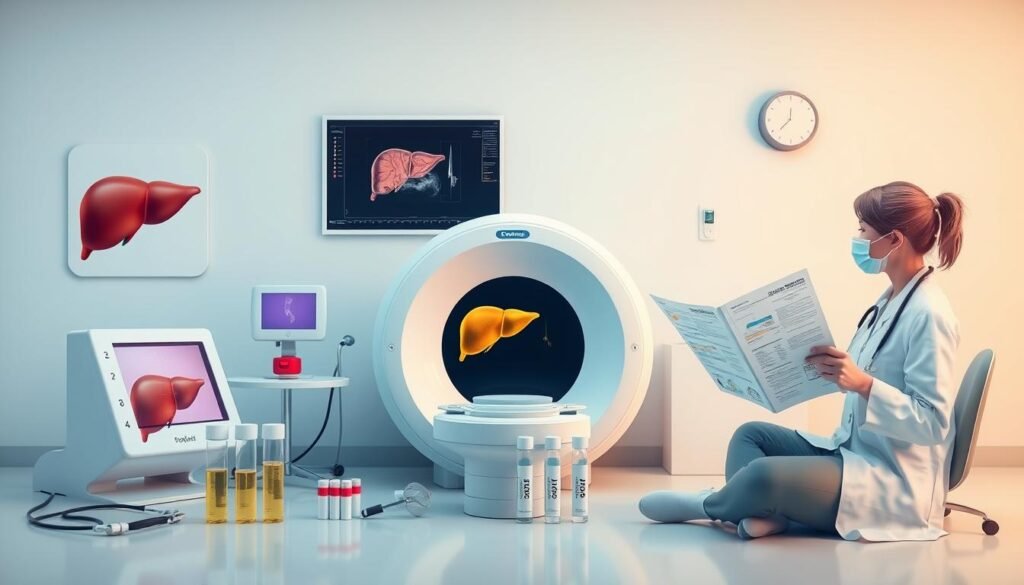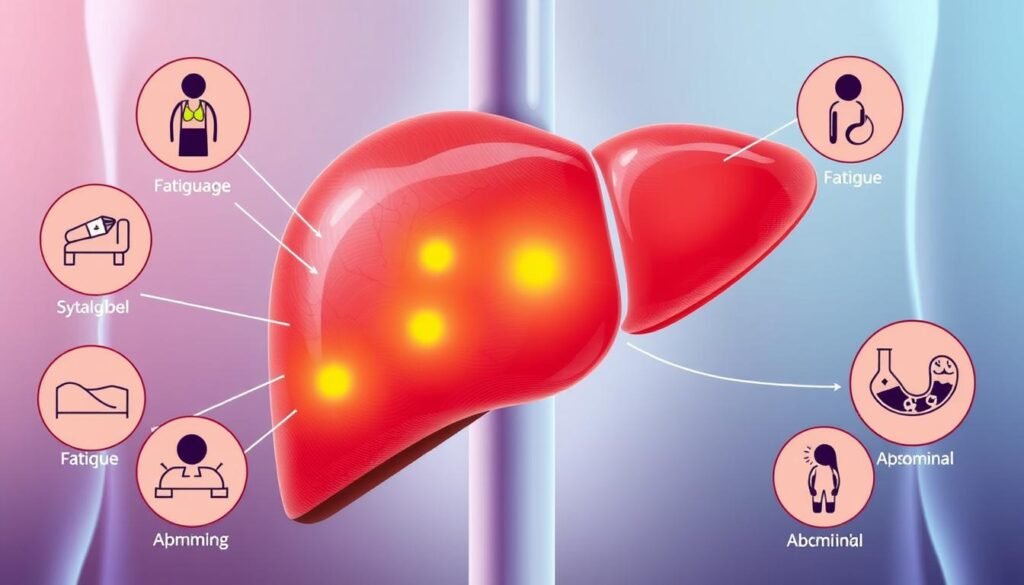About 25% of adults in the United States have nonalcoholic fatty liver disease (NAFLD). This condition is often missed but it’s very important for our health. Fatty liver disease means fat builds up in liver cells. This can lead to serious problems like cirrhosis and liver cancer. Symptoms vary from feeling tired to more serious health issues. Spotting this disease early is key to managing it well.
We will talk about the symptoms of fatty liver disease and ways to diagnose it. Knowing how to spot this disease early can make a big difference. For those wanting more details on NAFLD and its impact, there’s plenty to learn. The Mayo Clinic’s resource is a great place to start. It has lots of useful info on symptoms and how to find out if you have the disease.
Key Takeaways
- NAFLD affects about 25% of adults in the U.S.
- Early recognition is vital for effective management.
- Common symptoms include fatigue and potential liver complications.
- Diagnostic approaches are essential for timely intervention.
- Understanding risk factors can aid in prevention.
Understanding Fatty Liver Disease
Fatty liver disease occurs when too much fat builds up in liver cells. It has two main types: alcoholic liver disease and non-alcoholic fatty liver disease (NAFLD). Alcoholic liver disease comes from drinking too much alcohol. NAFLD is due to metabolic factors like obesity, diabetes, and metabolic syndrome.
Being overweight is a big cause of fatty liver disease. People who are overweight gather fat in their liver faster. High blood sugar or cholesterol also increases the risk. These elements together can up the chances of getting the disease. Knowing the exact causes helps in managing and treating it better.
The disease can get worse without action. It can turn into metabolic dysfunction-associated steatotic liver disease (MASLD). This can lead to metabolic dysfunction-associated steatohepatitis (MASH). MASH comes with fatigue and abdominal pain. Understanding the types of fatty liver disease helps in recognizing these stages early. This is vital for early diagnosis and treatment.
To sum up, fully understanding fatty liver disease means knowing its causes and types. This knowledge is key to managing your health better. Being aware helps in achieving better health outcomes and a healthier liver.
Symptoms of Fatty Liver Disease
It’s vital to know the symptoms of fatty liver disease for early treatment. Knowing the signs helps people and doctors catch it early. Symptoms vary depending on age, gender, and health. Here are the key signs of this illness.
Common Signs to Watch For
Early symptoms of fatty liver can be easy to miss. Common signs include:
- Fatigue: Feeling tired all the time, even after resting.
- Weight loss: Losing weight without trying to.
- Abdominal discomfort: Pain or discomfort, especially in the upper right side of the belly.
- Weakness: Feeling less strong or able physically.
Symptoms in Different Populations
How symptoms show can differ across groups. This varies due to:
- Age: Younger and older people may have different symptoms.
- Gender: Symptoms can be different for men and women.
- Health Conditions: Those with other health issues might experience unique symptoms.
Knowing these differences helps catch fatty liver disease earlier. It aids in creating better treatment plans for those at risk.
Recognizing Fatty Liver Disease
Understanding fatty liver disease is key to effective treatment and avoiding serious issues. Its early stages often show no symptoms, making it hard to find. It’s important for people to connect their lifestyle and any signs to their liver health.
Doctors should focus on checking those at risk, like those with obesity, diabetes, or metabolic syndrome. Your personal health history is very important here. It helps doctors know if you might have liver problems. Learning about the symptoms can help patients and doctors work together better.
Sometimes, symptoms like tiredness, belly discomfort, or weight changes might occur. Knowing these symptoms can assist everyone in recognizing fatty liver disease early. Catching the disease early can lead to treatments that greatly help your liver in the long run.
| Factor | Impact on Recognition |
|---|---|
| Asymptomatic Nature | Delays diagnosis and treatment |
| Personal Health History | Guides risk assessment and awareness |
| Education on Symptoms | Encourages proactive health discussions |
| Screening for Risk Factors | Improves early detection rates |
Diagnostic Approaches
Finding fatty liver disease early makes a big difference in health. There are many ways doctors can check for fatty liver. They start with simple checks and blood tests to see how the liver is doing.
Initial Assessments
First, doctors do a careful physical check and look at the patient’s history. They ask about symptoms, how the patient lives, and past health issues. These steps are crucial:
- Weight evaluations: They look at BMI and waist size.
- Family history: They see if liver diseases run in the family.
- Risk factor discussions: They talk about drinking and medicine use.
Blood Tests and Liver Enzyme Levels
Blood tests are key for spotting fatty liver disease. These tests check levels of liver enzymes like ALT and AST. High levels can show liver problems. It’s important to understand these test results.
Here’s a quick look at liver enzyme levels:
| Enzyme | Normal Range | Indication of Elevated Levels |
|---|---|---|
| ALT | 7-56 U/L | Liver damage or inflammation |
| AST | 10-40 U/L | Liver and muscle damage |
Using these methods to check for fatty liver helps doctors plan the best care for those at risk.

Imaging Techniques in Diagnosis
Imaging techniques are crucial for diagnosing fatty liver disease. They help spot how much fat is in the liver. Abdominal ultrasound is often the top pick because it’s easy to use and works well.
The Role of Abdominal Ultrasound
Doctors rely on abdominal ultrasound to find fat in the liver. It uses sound waves to make liver images. This lets doctors check the liver’s size and its fat levels. However, it’s not the best at catching mild fat buildup. While helpful, it sometimes needs backup from other, more detailed tests.
Other Imaging Options
Other than ultrasound, CT scans and MRI also help diagnose fatty liver. They provide clearer, more detailed views. These methods can measure liver fat better than ultrasound but might cost more and, for CT scans, involve radiation. Each imaging method has its pros and cons, making it important to choose based on what the patient needs.
| Imaging Technique | Pros | Cons |
|---|---|---|
| Abdominal Ultrasound | Non-invasive, low cost, widely available | Limited sensitivity for mild steatosis |
| CT Scan | High-detail imaging, quantifies fat accurately | Higher cost, radiation exposure |
| MRI | No radiation, excellent soft tissue contrast | Costly, longer duration of the procedure |
For detailed info on these imaging techniques, see this study on fatty liver diagnosis.
Understanding Non-Alcoholic Fatty Liver Disease (NAFLD)
Non-Alcoholic Fatty Liver Disease (NAFLD) raises concerns, especially for those who don’t drink alcohol. It’s where fat builds up in the liver, which can lead to inflammation and affect liver function. Knowing about this disease is key to managing and treating it well.
There are two main kinds of NAFLD: simple steatosis, with no inflammation or liver harm, and non-alcoholic steatohepatitis (NASH), which involves liver inflammation and damage. Finding NAFLD early is crucial. Without early detection, it could get worse, leading to serious liver issues like fibrosis, cirrhosis, and even cancer in the liver.

Understanding NAFLD well helps with early action. Routine health checks and tests can make a big difference for those at risk. Making lifestyle changes, like eating better and exercising regularly, can help manage NAFLD and might even turn it around.
It’s vital to know the risk factors of NAFLD to prevent it. Things like being overweight, insulin resistance, and certain metabolic issues increase the risk. Recognizing these can help healthcare professionals provide customized care plans, improving patient health over time.
| Classification | Description |
|---|---|
| Simple Steatosis | No liver inflammation; usually benign |
| Non-Alcoholic Steatohepatitis (NASH) | Involves liver inflammation and damage; higher risk of severe liver disease |
Risk Factors for Fatty Liver Disease
It’s key to know the risk factors for fatty liver disease to prevent and manage it well. Metabolic syndrome plays a big part. It combines conditions like obesity, high blood pressure, and insulin resistance.
These issues greatly affect the liver. They make fatty liver more likely to happen.
Metabolic Syndrome and Its Implications
Metabolic syndrome includes conditions that up the risk for fatty liver disease. If you have metabolic syndrome, your body might struggle with using glucose well. This can lead to more fat in the liver.
Doctors look at your waist size, triglyceride levels, and blood pressure to diagnose it.
Impact of Obesity and Type 2 Diabetes
Obesity is a main risk factor tied to fatty liver disease. Being overweight makes you more prone to this disease. This is because extra fat can build up in the liver tissues.
Type 2 diabetes also increases the risk of liver problems. It often goes hand in hand with obesity. Many with type 2 diabetes show signs of fatty liver disease. This shows how crucial it is to keep an eye on both conditions.
Treatment Options and Lifestyle Modifications
To get better from fatty liver disease, changing how you live is key. It’s important to eat better and move more. These changes can make a big difference in your liver’s health.
Dietary Changes
A good diet is very important for fighting fatty liver disease. Eating lots of fruits, vegetables, and whole grains helps your liver. Plus, it helps lower the fat in it. Here’s what to do:
- Limiting saturated fats and sugars
- Increasing fiber intake through whole grains and legumes
- Incorporating healthy fats, such as those found in avocados and olive oil
- Staying hydrated by drinking plenty of water
Making these diet changes can help you lose weight. This is very important for treating fatty liver. It also makes you healthier overall.
Physical Activity and Weight Management
Being active is also crucial. Doing things like walking fast or swimming helps your liver. It also helps you keep a healthy weight. Here’s what experts suggest:
- At least 150 minutes of moderate aerobic exercise each week
- Incorporating strength training exercises at least two days a week
- Finding enjoyable activities that can be sustained over time
Keeping a healthy weight with these changes can improve your fatty liver condition. It lessens liver fat and boosts your overall health.

| Aspect | Before Modifications | After Modifications |
|---|---|---|
| Fat Intake | High saturated fats | Lower saturated fats, increase in healthy fats |
| Sugar Intake | High sugar consumption | Reduced sugar intake |
| Physical Activity | Sedentary lifestyle | 150 minutes of exercise per week |
| Diet Variety | Limited fruits and vegetables | Rich variety of fruits, vegetables, and whole grains |
Preventive Measures
Preventing fatty liver disease is key to keeping healthy. Getting checked regularly helps catch issues early. Acting early helps people make smart health choices.
Regular Health Screenings
Health checks are vital for spotting liver problems. Seeing doctors often can alert you to liver health and risks you might face. Useful tests include:
- Blood tests to check liver enzymes and metabolic signs.
- Ultrasound imaging to look at the liver’s shape.
- Looking at body mass index (BMI) for weight-related risks.
These tests can spot problems quickly, lowering the chance of getting fatty liver disease.
Maintaining a Healthy Lifestyle
A good lifestyle is crucial to avoid fatty liver disease. Good habits that help your liver include:
- Eating well with lots of fruits, veggies, lean meats, and grains.
- Staying active with 150 minutes of exercise every week.
- Keeping your weight in check with proper food portions.
- Drinking less alcohol and steering clear of bad substances.
| Preventive Measure | Description |
|---|---|
| Health Screenings | Regular tests to keep an eye on liver function and catch issues soon. |
| Balanced Diet | Eating foods that are good for your whole body and liver. |
| Regular Exercise | Activities that help you stay at a healthy weight and lower liver fat. |
| Weight Management | Keeping a healthy weight with diet and exercise plans. |
| Limit Alcohol | Cutting back on drinks to ease up on your liver. |
Conclusion
This article has shed light on how to spot fatty liver disease. It highlights the need to know the symptoms and risk factors. Since fatty liver disease often goes unnoticed, raising awareness is crucial.
To diagnose fatty liver disease, a combination of methods is used. These include blood tests, imaging, and detailed assessments. It’s important for people to learn about these tools. This way, they can actively take care of their health.
Understanding fatty liver disease involves more than just its medical side. It’s about living healthily and getting regular check-ups. Taking action early can greatly reduce the risk of fatty liver disease. Awareness and education are key to a healthier tomorrow.